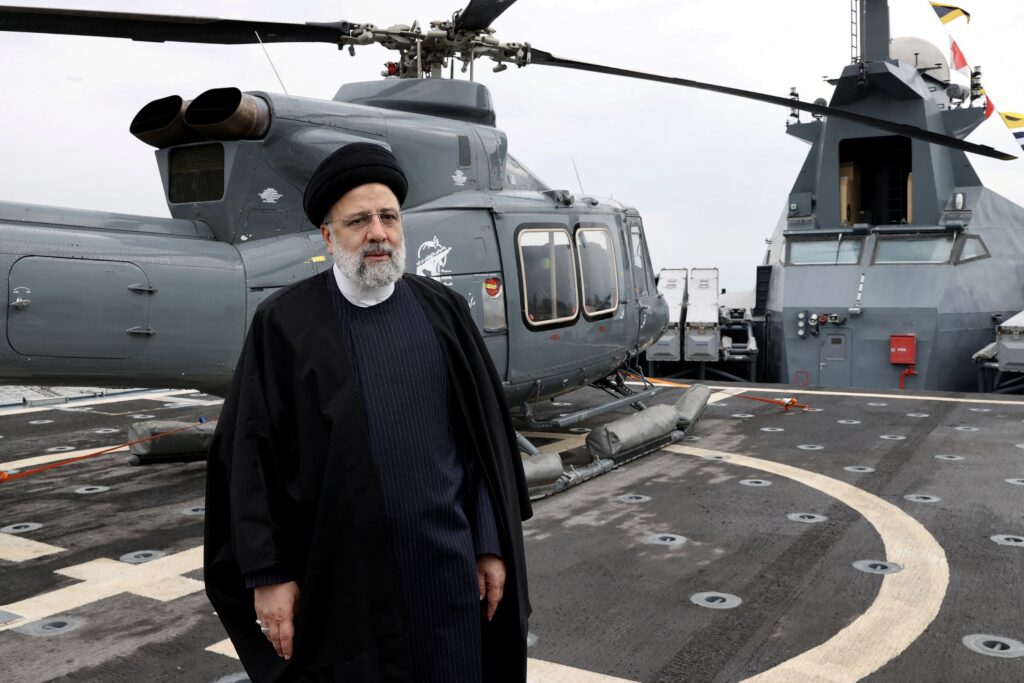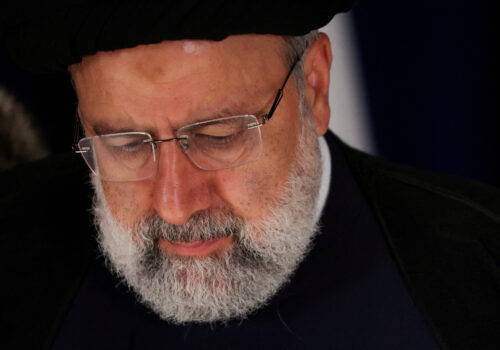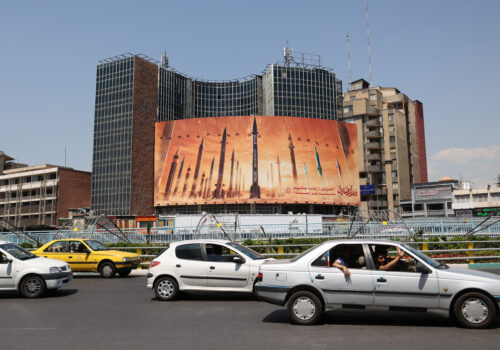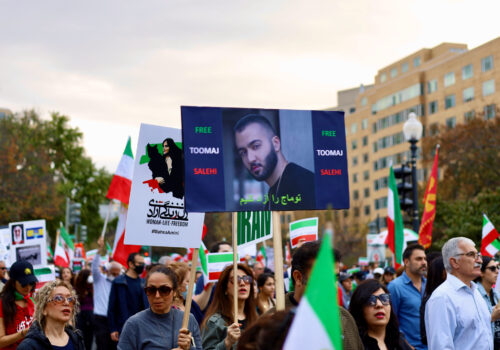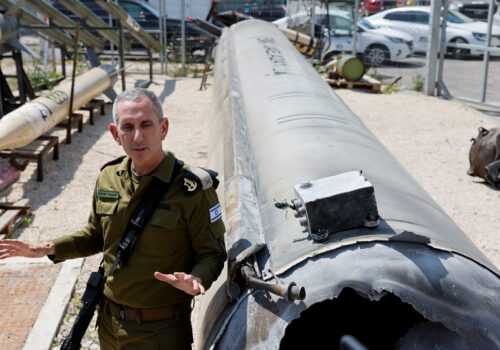“There is no sign of life from people on board,” reported state television. Iranian President Ebrahim Raisi and Foreign Minister Hossein Amir-Abdollahian died in a helicopter crash on Sunday in a mountainous area near Iran’s border with Azerbaijan. Raisi, a hardliner elected to the presidency in 2021, was seen as a likely successor to eighty-five-year-old Supreme Leader Ali Khamenei, who holds the ultimate power in Iran. What does the regime succession battle look like now? How will the crash shake up the region after Iran just exchanged blows with Israel? Our Iran watchers weigh in below.
Click to jump to an expert analysis:
Gissou Nia: Raisi was the architect and enforcer of crimes against humanity
Rob Macaire: Iran’s leaders now have succession dilemmas on their hands
Danny Citrinowicz: Raisi’s death is a blow to Khamenei
Holly Dagres: Many Iranians celebrated the news of Raisi’s death on social media
Masoud Mostajabi: Raisi followed the established conservative line. His successor likely will, too.
While Raisi’s death was shocking, it is unlikely to change Iran’s strategic direction
The death of Raisi in a helicopter crash on Sunday may have shocked the Middle East and broader world, but it is rather unlikely to alter Iran’s strategic direction in either domestic or foreign policy. While Raisi held the title of president, his authority was constrained by Iran’s supreme leader, within whom ultimate power is vested in the Islamic Republic.
But even so, Raisi’s death does leave a power vacuum in Iran. Section 131 of the Iranian constitution calls for First Vice President Mohammad Mokhber to assume power next. But Mokhber is unlikely to have any meaningful influence or seek to succeed Raisi. He will instead, as long as the constitution is followed, be replaced by a successor following an election within fifty days from when Raisi’s death was declared.
For the regime, another round of presidential elections is a headache that it would almost certainly have preferred to avoid. The Guardian Council—the body that determines which candidates are sufficiently loyal enough to the Islamic Republic’s ideology to be permitted to run—thought it had in Raisi a leader who would be around to take Iran into the next generation, likely a post-Khamenei one.
With that plan now shattered, the Guardian Council will likely be even more strict about who it allows to campaign, determined to ensure the next president can defend and protect the revolution at a time of domestic and regional upheaval.
—Jonathan Panikoff is the director of the Scowcroft Middle East Security Initiative in the Atlantic Council’s Middle East Programs and a former US deputy national intelligence officer for the Near East.
Read more:
Raisi was the architect and enforcer of crimes against humanity
For many Iranians, Raisi’s dominant legacy will be that of a career criminal whose commission of human rights violations spanned all four decades of the Islamic Republic.
As a young prosecutor in the 1980s, he quickly rose through the ranks with scores of execution requests against the newly established Islamic Republic’s political opponents. In 1988, he was one of four members of a “death commission” that sent thousands of political prisoners to execution after just a few short “yes” or “no” questions to test their political and religious beliefs. As judiciary chief in 2019 until he ascended to the presidency in 2021, he presided over a judiciary that violated Iran’s obligations under international law by ordering the executions of juveniles, protesters, ethnic and religious minorities, and LGBTQI+ persons.
In more recent years, he cut his reputation on his harsh crackdown on women’s rights and enforcing a system that many would call “gender apartheid.” He notoriously ordered the strict enforcement of the Islamic Republic’s mandatory hijab laws just two months before Mahsa Jina Amini was killed after being arrested for alleged improper hijab. Amini’s death triggered the nationwide “Woman Life Freedom” protests, and Raisi responded to this with force, instead of contrition. His government tried to push through a new bill with increased punishments for women who refuse to comply with compulsory hijab laws, replete with economic penalties. In March 2024, the United Nations Fact Finding Mission on Iran determined that the Islamic Republic of Iran authorities committed crimes against humanity in the September 2022 protests.
While a fatal helicopter ride means Iranians will not physically see Raisi in a defendant’s dock, his name will no doubt appear in future litigation as the architect and enforcer of policies that perpetrated the crimes against humanity of murder, rape, torture, and persecution.
—Gissou Nia is the director of the Strategic Litigation Project at the Atlantic Council.
Iran’s leaders now have succession dilemmas on their hands
In the wake of the news of Raisi’s death, the regime’s efforts to paint him as a popular figure who will be missed by ordinary Iranians seem doomed to fall flat. When regime leaders engineered Raisi’s victory in the 2021 elections by disqualifying any other credible candidates, they largely abandoned the fig leaf of democratic legitimacy that previous elections had conferred. He was certainly not in power because of his charisma or original thought: He was a textbook loyalist to the supreme leader.
Nevertheless, his sudden death will bring some dilemmas for the regime’s top leaders: How open a field will they allow for the new elections that are now required? Would they prefer a cleric, who might be seen as a potential contender to take over from Khamenei in due course, or a “technocrat”? How can they prevent the turnout (combined with spoiled ballots) from being even lower than last time? Would they, in fact, prefer the next president to be someone from the pragmatic or reformist camp who could then become the scapegoat for the state of the economy? This helicopter crash doesn’t threaten the regime, but it does bring a great deal of internal uncertainty at a time of external brinksmanship.
—Rob Macaire is a member of the Atlantic Council’s Iran Strategy Project and a former ambassador of the United Kingdom to the Islamic Republic of Iran.
Raisi’s death is a blow to Khamenei
The deaths of Raisi and Amir-Abdollahian are not expected to significantly alter Iran’s strategic directions, particularly not in the context of the Iranian nuclear issue. On matters significant to the regime’s future, the final arbiter is the leader of Iran, Khamenei. Therefore, Iranian policy will not be affected by Raisi’s death.
Still, Raisi’s death is very significant in the Iranian domestic view. The president actually functions as the prime minister, and he controls all areas of Iranian citizens’ lives. He is even in charge of the Supreme Council for National Security, the most significant body in Iran in issues related to national security, and he is responsible for making recommendations to the supreme leader on these subjects.
Therefore, the vacuum created after Raisi’s death, when the regime has already suffered a steep decline in public confidence, will increase the regime’s fear of political instability. Therefore, Iran’s supreme leader hastened to reassure the public that there would not be a political vacuum, and the regime will likely hasten to hold new elections.
It is important to note that Raisi’s death is also a harsh blow to Khamenei himself. He engineered Raisi’s election as president to ensure that the regime preserved its ideological identity after the Hassan Rouhani era and in a future succession process after Khamenei’s death. Raisi’s death may not only increase the succession struggles in Iran but also force Khamenei to choose a candidate who, like Raisi, will know how to stand firm and preserve the values of the revolution.
Raisi was a president who was not able to deal with the economic, social, and political challenges in Iran. Rather, his blind loyalty to the leader was his highest virtue. Khamenei, eager to preserve the core values of the revolution, will do his best to find a president who will preserve these values.
—Danny Citrinowicz is a nonresident fellow with the Atlantic Council’s Middle East Programs and a member of the Atlantic Council’s Iran Strategy Project working group. He previously served for twenty-five years in a variety of command positions units in Israel Defense Intelligence.
Many Iranians celebrated the news of Raisi’s death on social media
“The hope of the nation is with you two,” an Iranian X (formerly Twitter) user wrote with photos of a bear and wolf—a reference to how they hoped that Raisi and his entourage would be eaten or mauled to death by wild animals. This morbid theme was a common meme on Persian-language social media after news broke on Sunday that the president’s helicopter had suffered a “hard landing” while passing through the mountains of East Azerbaijan province. It underscored just how much hate many ordinary Iranians have for the clerical establishment that has ruled their country for more than four decades. Upon the news of the missing helicopter, the daughters of Minoo Majidi, a woman who was killed by security forces during the 2022 “Women, Life, Freedom” uprising, posted a video of themselves celebrating with alcohol—which became a common theme when it was confirmed that the president and his cohort had not survived.
While many seemed to be elated at the news, not all were celebrating. A group of regime supporters gathered in prayer in Tehran’s Valiasr Square for the president and his cohort, including Amir-Abdollahian, who was secondary in the news coverage (and a meme topic for that very reason).
The Islamic Republic has been marred by forty-five years of systemic mismanagement, corruption, and repression—and many Iranians want to break free of its chains of oppression. It’s no surprise that many had schadenfreude about the news of the demise of the “Butcher of Tehran.” Raisi served on one of the death commissions responsible for the mass execution of political prisoners in 1988, and his hands were also bloodied during his time as judiciary chief and later as president.
While Raisi was widely seen as an uncharismatic and ineffective president, he was apparently being groomed for the future role of supreme leader. Since coming to the political scene in 2017 as a rival candidate to then President Hassan Rouhani, the hardliner collected one credential after the next—most recently being handed the 2021 presidential election on a silver platter. Raisi was part of the supreme leader’s vision for an Islamic Republic 2.0, made up of relatively young and pious leaders carrying out Khamenei’s vision after his death. Now that one of Khamenei’s most loyal servants is dead, the succession line has only gotten smaller and more contested. With a historically low election turnout in March, this was a credibility headache the Islamic Republic didn’t need right now.
—Holly Dagres is a nonresident senior fellow and the editor of the Middle East Programs’ IranSource as well as MENASource publications and curator for the weekly newsletter, The Iranist.
Raisi followed the established conservative line. His successor likely will, too.
The deaths of Raisi and Amir-Abdollahian, along with several members of their delegation following a visit to Iran’s border with Azerbaijan, have sparked numerous questions for both domestic and international audiences. Domestically, the focus will be twofold: the upcoming election to replace the president and the potential succession of the supreme leader, for which many Western pundits have speculated Raisi was a top contender.
As for the presidency, Raisi was seen as an apparatchik who followed the established conservative line, and there are many within Iran’s conservative factions who will happily replace him. Likely candidates will emerge from these established circles in the coming weeks leading up to the special election, but they are unlikely to steer far from the path and tone set by the late president. Regarding the supreme leader’s succession, most theories remain speculative, as the nature of Iranian internal political dynamics are often opaque. One should, therefore, be cautious about making early predictions.
For neighboring countries and the international community, the primary concern will be identifying credible successors for Raisi and Amir-Abdollahian, who were preferred interlocutors for many due to their alignment with the supreme leader’s office and the Islamic Revolutionary Guard Corps. In a statement on May 19, the supreme leader emphasized that the administration of the country will remain stable, suggesting that significant changes in Iranian foreign and domestic policy are unlikely. The most noticeable impact might be a delay in ongoing US-Iran indirect negotiations, as Iranian leaders will likely prioritize the upcoming elections that must take place within fifty days.
—Masoud Mostajabi is a deputy director of the Middle East Programs at the Atlantic Council.
Further reading
Tue, Apr 23, 2024
This round of Iran-Israel escalation is over, but the next could be just around the corner
IranSource By
The continuous campaign between Iran and Israel is unlikely to end, and the precedent set by their direct military engagement has become another option on the confrontation table.
Fri, Apr 26, 2024
Everything you need to know about Iranian rapper Toomaj Salehi and his death sentence
IranSource By
On April 24, a revolutionary court in Iran sentenced dissident rapper Toomaj Salehi to death on charges of “spreading corruption on the Earth.”
Fri, Apr 19, 2024
Iran once had air inferiority. After its attack on Israel, it flies high.
IranSource By Borzou Daragahi
While much of the discussion of the Iran-Israel conflict has been focused on proxy ground attacks, clandestine operations, and cyberwarfare, April 14 marks a new and dangerous escalation in the skies.
Image: Iranian President Ebrahim Raisi visits the military equipment of IRGC Navy in Bandar Abbas, Iran, February 2, 2024. Iran's Presidency/WANA (West Asia News Agency)
